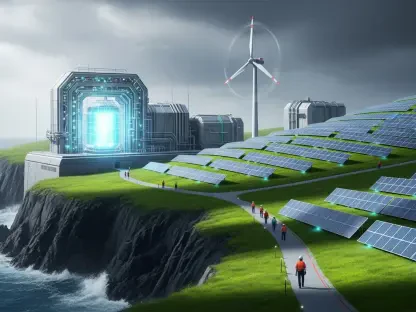As energy demands soar and global pressures mount, Belgium finds itself at a critical juncture in its approach to nuclear power, with the recent shutdown of the Tihange-1 nuclear power plant after 50 years of service symbolizing both an end and a potential new beginning. Located in Huy and operated by Engie, this facility generated an impressive 327 terawatt-hours of electricity over its lifetime, preventing 148 million tons of CO2 emissions. Yet, its closure has ignited local frustration, particularly among municipal leaders who relied on the plant for economic stability and to meet the rising electricity needs of modern industries and electric vehicles. This moment reflects a broader shift in national energy policy, driven by geopolitical tensions and the urgent need for energy security, prompting a reevaluation of long-standing plans to phase out nuclear power entirely. The evolving debate encapsulates a delicate balance between environmental aspirations and pragmatic energy solutions.
Shifting Policies in a Changing World
Energy Crisis and Geopolitical Influences
The landscape of Belgium’s energy policy has undergone a dramatic transformation in recent years, largely influenced by external crises and internal demands that have challenged the original intent of the 2003 nuclear phaseout law. Initially designed to shutter all seven of the country’s nuclear reactors by this year, the policy faced significant pushback as the energy crisis deepened, compounded by geopolitical unrest such as Russia’s war against Ukraine. This situation exposed vulnerabilities in energy supply chains, leading to a pivotal decision in 2022 to extend the operational life of the two newest reactors, Doel-4 and Tihange-3, for an additional decade. Agreements finalized recently have also shifted financial responsibilities for nuclear waste management to the state, easing the burden on operators. This reversal highlights how global uncertainties can reshape national strategies, forcing a reconsideration of nuclear power as a reliable and carbon-free energy source amid fluctuating fossil fuel markets and international pressures.
Political Realignment and Future Commitments
Beyond immediate crises, a significant political shift has further altered Belgium’s nuclear trajectory, with a new governing coalition taking a bold stance earlier this year to overturn the longstanding phaseout law. This move signals a long-term commitment to nuclear energy, not just through extensions of existing facilities but also by opening discussions on constructing new reactors. The government has secured approval from the European Commission for state support to Engie, ensuring the financial viability of extending reactor operations. This policy pivot reflects a consensus on the necessity of nuclear power to achieve a balanced energy mix, targeting a 4-gigawatt nuclear share in the near future, which would require the operation of four reactors. Such ambitious goals underscore a strategic vision that aligns energy security with environmental targets, acknowledging nuclear power’s role in reducing carbon emissions while addressing the practical challenges of transitioning to renewable alternatives in a timely manner.
Balancing Energy Needs and Local Impacts
Economic and Social Fallout of Closures
The decommissioning of Tihange-1 has brought to light the profound economic and social consequences for communities like Huy, where the plant was a cornerstone of local finances and energy provision. Municipal leaders have voiced deep concerns over the loss of a dependable power source that supported growing demands from businesses and the increasing adoption of electric vehicles. The closure disrupts not only revenue streams but also the sense of stability for residents who depended on the plant’s presence for decades. Mayor Christophe Collignon has been vocal about the immediate impact, emphasizing how such shutdowns exacerbate the challenges of meeting modern energy needs without viable alternatives in place. This situation illustrates the tension between national policy decisions and localized repercussions, highlighting the need for comprehensive support mechanisms to mitigate the fallout for affected areas as Belgium navigates its energy transition.
Challenges of Decommissioning and Reactor Viability
As Belgium grapples with the staggered shutdown of its nuclear fleet, including Doel-3 and Tihange-2 in recent years and Doel-1 earlier this year, the complexities of decommissioning older reactors like Tihange-1 come into sharp focus. Despite a previous 10-year extension granted in 2015, further operation of Tihange-1 was deemed unfeasible due to the significant safety upgrades and financial investments required, which Engie was unwilling to shoulder. Current discussions, led by Energy Minister Mathieu Bihet, aim to prevent irreversible decommissioning steps at the site, with local reports indicating that full decommissioning isn’t scheduled until 2028. This delay offers a window for potential reevaluation, reflecting a broader struggle to balance the costs of maintaining aging infrastructure against the benefits of sustained nuclear capacity. The reluctance of operators to invest in older plants contrasts with governmental efforts to retain nuclear power, revealing a critical challenge in aligning economic realities with strategic energy goals.
Charting a Sustainable Energy Path
Reflecting on a Pivotal Transition
Looking back, the closure of Tihange-1 marked a defining chapter in Belgium’s energy history, encapsulating the intricate dance between past commitments to phase out nuclear power and the pressing demands of a carbon-conscious era. The government’s earlier decisions to extend reactor lifespans and ultimately reverse the phaseout law demonstrated a pragmatic response to unforeseen global challenges and local energy needs. Communities bore the brunt of these shifts, as economic stability waned with each shutdown, while national strategies adapted to prioritize energy security over ideological stances. This period of transition revealed the nuanced interplay of policy, economics, and environmental aspirations, as Belgium sought to redefine its energy identity in a rapidly changing world, learning from each closure the importance of foresight and adaptability in energy planning.
Embracing Nuclear as a Cornerstone for Tomorrow
Moving forward, Belgium stands at a crossroads where embracing nuclear power could serve as a linchpin for achieving long-term sustainability and energy independence. Policymakers should focus on fostering innovation in reactor technology and safety protocols to ensure older plants can operate viably or be replaced with modern alternatives. Investing in community transition programs will be crucial to support areas impacted by closures, offering retraining and economic diversification to offset losses. Additionally, public-private partnerships could streamline the development of new nuclear projects, ensuring that financial burdens are shared equitably while advancing carbon neutrality goals. As discussions continue on maintaining capacity and building anew, a transparent dialogue with stakeholders at all levels will help align national objectives with local realities, paving the way for a resilient energy framework that honors both environmental commitments and societal needs.









